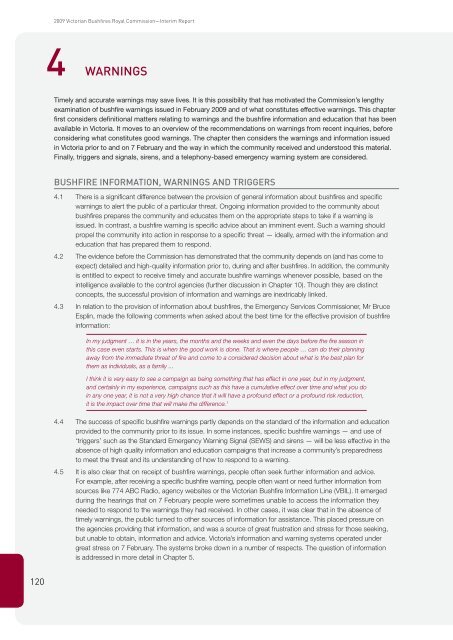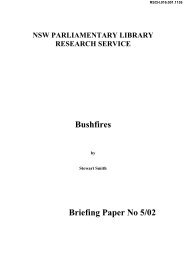Chapter 4 - Warnings - 2009 Victorian Bushfires Royal Commission
Chapter 4 - Warnings - 2009 Victorian Bushfires Royal Commission
Chapter 4 - Warnings - 2009 Victorian Bushfires Royal Commission
You also want an ePaper? Increase the reach of your titles
YUMPU automatically turns print PDFs into web optimized ePapers that Google loves.
<strong>2009</strong> <strong>Victorian</strong> <strong>Bushfires</strong> <strong>Royal</strong> <strong>Commission</strong>—Interim Report<br />
4 WARNINGS<br />
Timely and accurate warnings may save lives. It is this possibility that has motivated the <strong>Commission</strong>’s lengthy<br />
examination of bushfire warnings issued in February <strong>2009</strong> and of what constitutes effective warnings. This chapter<br />
first considers definitional matters relating to warnings and the bushfire information and education that has been<br />
available in Victoria. It moves to an overview of the recommendations on warnings from recent inquiries, before<br />
considering what constitutes good warnings. The chapter then considers the warnings and information issued<br />
in Victoria prior to and on 7 February and the way in which the community received and understood this material.<br />
Finally, triggers and signals, sirens, and a telephony-based emergency warning system are considered.<br />
BUSHFIRE INFORMATION, WARNINGS AND TRIGGERS<br />
4.1<br />
4.2<br />
4.3<br />
There is a significant difference between the provision of general information about bushfires and specific<br />
warnings to alert the public of a particular threat. Ongoing information provided to the community about<br />
bushfires prepares the community and educates them on the appropriate steps to take if a warning is<br />
issued. In contrast, a bushfire warning is specific advice about an imminent event. Such a warning should<br />
propel the community into action in response to a specific threat — ideally, armed with the information and<br />
education that has prepared them to respond.<br />
The evidence before the <strong>Commission</strong> has demonstrated that the community depends on (and has come to<br />
expect) detailed and high-quality information prior to, during and after bushfires. In addition, the community<br />
is entitled to expect to receive timely and accurate bushfire warnings whenever possible, based on the<br />
intelligence available to the control agencies (further discussion in <strong>Chapter</strong> 10). Though they are distinct<br />
concepts, the successful provision of information and warnings are inextricably linked.<br />
In relation to the provision of information about bushfires, the Emergency Services <strong>Commission</strong>er, Mr Bruce<br />
Esplin, made the following comments when asked about the best time for the effective provision of bushfire<br />
information:<br />
In my judgment … it is in the years, the months and the weeks and even the days before the fire season in<br />
this case even starts. This is when the good work is done. That is where people … can do their planning<br />
away from the immediate threat of fire and come to a considered decision about what is the best plan for<br />
them as individuals, as a family ...<br />
I think it is very easy to see a campaign as being something that has effect in one year, but in my judgment,<br />
and certainly in my experience, campaigns such as this have a cumulative effect over time and what you do<br />
in any one year, it is not a very high chance that it will have a profound effect or a profound risk reduction,<br />
it is the impact over time that will make the difference. 1<br />
4.4<br />
4.5<br />
The success of specific bushfire warnings partly depends on the standard of the information and education<br />
provided to the community prior to its issue. In some instances, specific bushfire warnings — and use of<br />
‘triggers’ such as the Standard Emergency Warning Signal (SEWS) and sirens — will be less effective in the<br />
absence of high quality information and education campaigns that increase a community’s preparedness<br />
to meet the threat and its understanding of how to respond to a warning.<br />
It is also clear that on receipt of bushfire warnings, people often seek further information and advice.<br />
For example, after receiving a specific bushfire warning, people often want or need further information from<br />
sources like 774 ABC Radio, agency websites or the <strong>Victorian</strong> Bushfire Information Line (VBIL). It emerged<br />
during the hearings that on 7 February people were sometimes unable to access the information they<br />
needed to respond to the warnings they had received. In other cases, it was clear that in the absence of<br />
timely warnings, the public turned to other sources of information for assistance. This placed pressure on<br />
the agencies providing that information, and was a source of great frustration and stress for those seeking,<br />
but unable to obtain, information and advice. Victoria’s information and warning systems operated under<br />
great stress on 7 February. The systems broke down in a number of respects. The question of information<br />
is addressed in more detail in <strong>Chapter</strong> 5.<br />
120
















